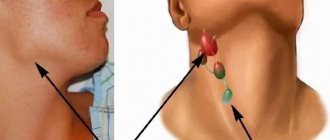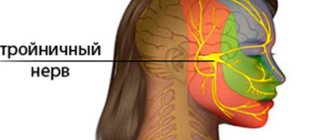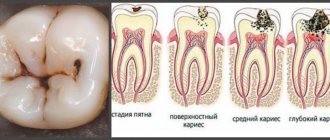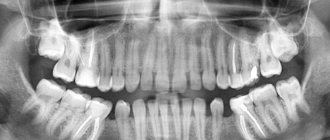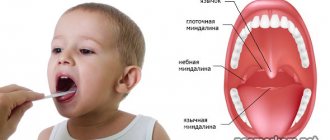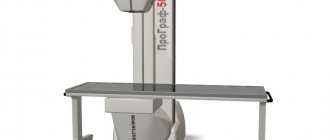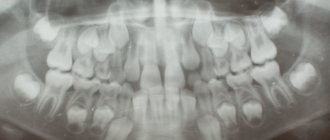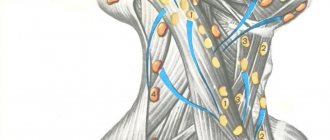Lump under the chin
An internal lump on the chin under the skin appears as a neoplasm that may appear suddenly. In the evening a person falls asleep without having problems with the skin, and in the morning he discovers a cosmetic defect.
Most often, the location of the pathological element is under the lower jaw or in the occipital region. It is there that the lymph nodes are located, which tend to increase due to existing inflammatory processes.
In case of viral, infectious and bacterial pathologies, activation of these nodes is observed, as a result of which they become larger. The lymphatic system in the human body acts as a kind of filter that prevents inflammation from spreading throughout the body.
Advice: When a lump in the chin area feels hard, stiff and extremely painful, it is recommended to immediately consult a doctor. These signs indicate a developing tumor, which, unfortunately, is not always benign.
Note that if the lump appears within a few days or even a couple of hours, then there is no need to panic, it is definitely not cancer. Oncological compactions develop gradually and relatively slowly, and other negative signs are always observed.
Treatment - what to do with a lump on the chin under the skin that hurts?
The first thing a patient should do if he discovers a nodular tissue compaction resembling a tumor on his chin or under it is to contact a medical institution at his place of residence, or the nearest clinic. It all depends on the general well-being of the person. Therapy for the neoplasm is based on the presence of which particular disease caused the formation of a lump in the subcutaneous layer. Treatment may include the following procedures:
Antiseptic therapy
The presence of a purulent pustule inside the lump, formed as a result of the formation of an infectious abscess, requires the use of antibacterial drugs that suppress the activity of the bacterial pathogen. Tablets and intramuscular antibiotics are used in the form of injections. The type of drug is determined solely by the attending physician, based on what type of infection was detected during laboratory testing. As the bacterial population decreases, inflammation goes away, and the lump acquires a soft structure and gradually resolves.
Warming up
In some cases, patients with a lump in the chin area are shown electrophoresis to warm up areas of the skin in order to speed up blood circulation in the epithelial tissues and prevent the re-formation of a benign tumor. As a rule, this element of therapy is used in the treatment of epidermal cysts.
Surgery
A universal and conservative method of treating tumors of all types formed in the chin area. Surgical intervention involves performing a local strip operation with dissection of the skin and mechanical removal of wen, abscesses, cysts and other foreign formations that were found in the surface layer of the epithelium. The method is really effective and allows you to avoid relapses of the disease, but it traumatizes the skin, and the healing time for the suture can be from 2 to 3 weeks.
Chemotherapy and cytostatics
If a patient is diagnosed with a malignant tumor under the chin, which really threatens his life, doctors develop a comprehensive therapeutic protocol, which includes surgical removal, radio wave irradiation and physiotherapy. A key element in the course of treatment is the use of chemicals that kill cancer cells and reduce the size of the tumor. They also do not allow the malignant neoplasm to spread its metastases throughout the body.
The disadvantage of chemotherapy is that the toxic substances contained in drugs in this category kill not only cancer cells, but also destroy healthy tissue of vital human organs. Therefore, cancer patients feel very bad after undergoing another course of chemotherapy. Treatment with cytostatic drugs allows for a targeted effect on tumor cells without harming other tissues. Cytostatics are new generation drugs that allow you to remove a malignant lump under the chin without harming the overall health of the body.
Source: furunkul.com
Why did a lump appear on the neck under the chin?
There are many lymph nodes in the human body, including those located under the lower jaw. They support the functioning of the immune system. In case of pathological processes in the body, they try to neutralize them.
From a medical point of view, to identify the cause of abnormal swelling of the node, you need to look for a disease. Usually the cause of the occurrence lies in pathologies of the upper respiratory tract, sometimes in dental problems.
Often the cause is severe sore throat, tonsillitis or pharyngitis. The inflammatory process tends to intensify due to the lack of adequate treatment, smoking and drinking alcoholic beverages.
The compaction under the skin can be leveled out on its own if the immune system effectively fights pathogenic agents. When the immune system is weakened, the alarming symptoms will intensify.
If a lump appears under the chin, then the reasons are conditionally divided into two groups:
- Nonspecific etiology is caused by the penetration of pathogenic microorganisms, viruses and bacteria, which led to an inflammatory process in the lymph node. These may be pathologies of the oral cavity, gingivitis, stomatitis, etc. In children - rubella, measles, mumps;
- Specific pathogenesis is based on pathogens - syphilis, tuberculosis, brucellosis. If in the first case the lump does not hurt, then in this version there is noticeable pain. Causes – lymphoma (tumor neoplasm of the lymphatic system), oral cancer, pharyngeal cancer, etc.
It is worth knowing: at an advanced stage of development, any oncological process in the body can become a provoking factor, which leads to an increase in peripheral organs in the lymphatic system.
Causes of acute inflammation of the lymph nodes under the lower jaw
The main reasons contributing to inflammation of the lymph nodes:
- infectious diseases: rubella, influenza, stomatitis, tonsillitis;
- HIV infection;
- weakened immune system;
- oncological diseases;
- mechanical injuries;
- herpes simplex virus;
- teeth destroyed by caries;
- chronic diseases of the ENT organs.
For example, with a sore throat, the submandibular lymph nodes on both sides are inflamed. And with pulpitis or alveolitis, only one organ located near the source of infection will be enlarged. With mumps or toxoplasmosis, several groups of nodes are involved in the process.
Most often, the pathology is diagnosed in young children and adolescence, when the immune system is most weakened and vulnerable. In the foreground are the signs of the underlying disease, which caused an inflammatory process in the lymphoid tissue.
Clinical symptoms of lymphadenopathy:
- low-grade body temperature;
- enlarged lymph nodes under the lower jaw;
- the nodes hurt on palpation;
- discomfort when swallowing food or opening the mouth.
Dental diseases
This process is especially dangerous for pathologies of the wisdom tooth, since it is located near large blood vessels. Pus can enter the bloodstream and cause sepsis.
The inflamed lymph node usually increases in size and can be easily felt. This creates an uncomfortable feeling. The organ has a dense consistency and is mobile.
Not only teeth can cause inflammation of the submandibular lymph nodes. The cause may also be diseases of the throat, nose or ears. Acute tonsillitis (tonsillitis), otitis media or sinusitis also lead to an increase in nodes under the lower jaw.
With sinusitis, the bridge of the nose, the area under the eyes and between the eyebrows hurt, purulent rhinitis appears, and the sense of smell is impaired. The chronic form of the disease has more vague symptoms, there is constant nasal congestion, and the pathology periodically worsens.
When the submandibular lymph nodes fail to cope with their function, a sharp increase in their size occurs, a purulent process forms, and swelling appears in the neck. The patient's health worsens. Adjacent lymph nodes may also be involved in the process.
The main symptoms of the pathologies: enlarged lymph nodes in the neck, under the lower jaw, as the parasites spread by lymphogenous and hematogenous routes. These dangerous diseases are asymptomatic for a long time, affecting internal organs, the brain, eyes, nervous system, and muscle tissue.
Treatment is prescribed by an infectious disease doctor. Patients take antiparasitic, antiviral and antifungal drugs. Unfortunately, toxoplasmosis cannot be completely cured; antibodies and the parasite itself remain in the body for life. Taking medications relieves inflammation and prevents the development of complications.
Additionally, you may need to undergo laboratory blood and urine tests, ultrasound, computed tomography, and biopsy.
Treatment is prescribed by a therapist, ENT specialist, dentist, surgeon, oncologist or infectious disease specialist, depending on the causative agent of the pathology. In case of acute inflammation, antibiotics, antiviral, antibacterial drugs, and antimycotics are prescribed.
If the disease is advanced and purulent lymphadenitis has developed, the pathology must be treated by surgically opening the node to drain out the necrotic masses. The organ is washed and a soft rubber drainage is installed. As part of the therapy, the patient undergoes drug treatment: antibiotics, anesthetics, antipyretics.
You cannot treat lymph nodes with warm compresses, this can increase inflammation and accelerate the formation of purulent masses!
For inflammation of the submandibular lymph nodes, treatment should not only be symptomatic, but also aimed at eliminating the preconditions that led to the development of the disease. To determine them, a thorough diagnosis is carried out, with the help of which it is possible to either identify or exclude serious infectious diseases.
Inflammation of the lymph nodes is called lymphadenitis. The disease occurs spontaneously and has three stages of development. Signs of the disease appear in the following order:
- The first stage is characterized by enlarged nodes and pain on palpation. Inflammation of the lymph node under the jaw is accompanied by insomnia, headache, chronic fatigue, and fever.
- The second stage (see photo) is acute and clearly expressed in appearance: the tumor is visible even without palpation. The movement of the jaw is limited, severe pain appears, the temperature rises, and suppuration forms.
- Third stage. The pain spreads to other areas: neck, collarbones, armpits. Inflammation of the nerves of the teeth and throat is observed.
When an enlargement of the submandibular lymph nodes occurs, the first thing to do is visit a doctor. You cannot self-medicate. But it is possible to suggest the cause of the disease. For example, the round shape of a compaction indicates the presence of diseases of the ENT organs. With such ailments, the lymph node remains mobile.
If the lymph node on the neck on the left under the jaw hurts, then the source of inflammation is nearby. Lymphadenitis, which can develop as a result of mechanical damage to the tissues of the node itself, cannot be excluded.
To eliminate inflammation, the patient will need to see an otolaryngologist. He will ask the patient to undergo a series of tests:
- ultrasound diagnostics;
- blood tests;
- laboratory research on bacterial genomes;
- fluorographic diagnostics;
- tests for reactive protein and others.
Inflammation of the lymph nodes is called lymphadenitis. As mentioned earlier, this condition is a reaction of the immune system to damage to the body by microbes and viruses.
Another cause of inflammation of the submandibular lymph nodes is acute respiratory diseases and influenza. The process indicates excellent functioning of the immune system. Such ailments are characterized by symptoms indicating that lymphocytes are actively fighting viruses and infections.
- weakness, elevated body temperature;
- migraine;
- irritation of the nasal mucosa, throat;
- body aches.
Enlarged lymph nodes occur with AIDS, genitourinary infections, and syphilis. Only with such pathologies, not only the submandibular nodules increase.
Systemic disorders of the immune system also provoke disease of the lymphatic system. This is when there are sluggish inflammatory processes in the body:
- rheumatism;
- serum pathology;
- lupus erythematosus;
- Infectious mononucleosis.
With mumps (see photo), infection in the oral cavity, swelling of the nodes on the left or right under the jaw is observed. Depending on which side of the jaw glands is inflamed. If the right (left) is swollen, this is a sign of infection of the right (left) salivary gland. This condition is accompanied by an inflammatory process and swelling in the cervical area. When pressed, the submandibular lymph nodes have a solid base.
We invite you to familiarize yourself with Scattered partial absence of teeth - TOP 15 dental problems
Disruption of the lymphoid system occurs in dental ailments:
- Caries leads to manifestations of purulent abscesses that develop near the root of the tooth, this condition causes swelling of the gums. As a result, the nodes become inflamed. If the infection is in the mouth on the right, then in this part they increase. And removing the tooth will solve the problem.
- If wisdom teeth grow in an adult, then the lymphoid system instantly reacts to the process.
- After tooth extraction with complications, this system also perceives the process as a threat to the immune system. After the gums heal, everything will return to normal.
- Periodontal disease, stomatitis, cysts, tartar, which contribute to the development of periodontitis, negatively affect lymph exchange.
Soft swelling under the chin or in the upper part of the neck, sometimes painful, is one of the symptoms of inflammation of the cervical lymph nodes. Lumps in the back of the head may indicate cancer has spread to the lymph nodes in the neck. The skin on the surface of the node becomes red and inflamed. Sometimes a swollen lymph node is similar to a common cold or respiratory illness.
The main task performed by the lymph nodes in our body is to filter pathogens that enter it from the outside. They are located in groups that can be felt with your hands, but there are also single nodules.
In their normal state, their size does not exceed a pea and it is visually impossible to discern them. They are located on vessels that provide lymph flow. We need this liquid to maintain natural immunity. When an infection enters our body, our immune system throws all its strength into fighting it, activating the production of lymph, which leads to a change in the size of the lymph nodes. Their
, the cause of which must be immediately determined. Until it is clarified, no procedures, such as warming up, are recommended to be carried out with them.
Quite often, it is the submandibular lymph nodes that come under attack. Their inflammation is diagnosed in both children and adults. If the lymph nodes under the lower jaw hurt and are enlarged, the cause of this must be determined immediately, since inflammation left unattended is fraught with suppuration and other unpleasant complications, which will not be easy to get rid of.
The photo shows very accurately how the lymph nodes under the jaw became inflamed and swollen. It is impossible not to notice and miss this state. In children, the lymph nodes are smaller, but in an inflamed state they can also be easily felt by palpation.
The first signs of cancer and benign tumors
If a lump appears on your chin, you should visit a doctor. You won't be able to solve the problem on your own. Ignoring an obvious symptom and other characteristic signs can cost the patient’s life.
Signs of a benign neoplasm: the lump at the bottom of the chin is soft and mobile to the touch; upon palpation, slight discomfort or severe pain may be felt. In the latter case, the symptom indicates severe inflammation.
Symptoms of a compaction of a malignant nature include a hard neoplasm to the touch, it is not mobile, as if it is growing “inside” the face, there is severe pain in the absence of touching the pathological element.
Lipoma
A large pimple on the chin may be a lipoma. Lipoma is a benign formation that is formed from growing adipose tissue. In 98% of clinical pictures, there are no subjective sensations other than appearance.
If the tumor grows rapidly, pain is observed due to compression of surrounding tissues. The lump is soft and elastic to the touch, the size varies from 1 to 5 centimeters, most often it forms on the neck.
Folliculitis
It is a skin pathology. In medical practice, the disease is classified as a form of superficial pyoderma. The disease is accompanied by inflammatory processes in the upper parts of the hair follicles. It is infectious in nature.
There are several types of folliculitis, which are caused by a specific pathogen. There are staphylococcal, candidal, herpetic, acne and other varieties.
Malignant tumor
A tumor containing malignant cells appears as a cancer. It is difficult to describe the initial symptoms of cancer, since there are many types of them. External manifestations include swelling and compaction under the skin. They usually develop in advanced stages.
Additional symptoms: painful lymph nodes, enlarged liver, neurological phenomena (dizziness, constant headaches), joint pain, non-productive cough (sometimes mixed with blood).
The main methods of therapy include surgery, chemotherapy, radiotherapy, taking hormonal pills, and the use of powerful medications aimed at strengthening the immune status. The prognosis is determined by the type of disease and timely diagnosis.
Skin cyst
A closed cavity neoplasm of the skin and mucous membranes, which is lined with epithelial tissue or epidermis, containing contents of varying consistency - a skin cyst of true nature. The pseudocyst lacks an epithelial lining.
The compaction in the form of a cyst tends to grow quickly, which leads to subsequent rupture of the walls of the neoplasm; the contents enter the dermis, which provokes the development of a strong inflammatory process. Pain syndrome is noted.
Atheroma
The compaction is of a benign nature, contains sebum inside, and does not pose a threat to human life and health. With active growth, it can compress neighboring tissues, which leads to inflammation.
For your information, visually atheroma appears as a painful compaction that has clear boundaries and rises above the surface of the skin. Inside the element is the secretion of the sebaceous glands, epithelial cells, hairs - they look like a cheesy substance, placed in a capsule. It is the capsule that prevents the contents of the atheroma from “escaping.”
The “ball” under the skin increases relatively slowly. However, in the absence of proper therapy, it can reach up to 5 centimeters or more.
What could it be - the causes of a tumor on the chin
If the development of a tumor under the chin occurred suddenly, then this is not a reason to sound the alarm. Most likely, this is a peculiar manifestation of local inflammation and an internal pimple with a purulent pustule has formed in the subcutaneous layer, formed as a result of penetration of a pathogenic infection into the skin. Also, the appearance of a lump under the chin that resembles a tumor may be due to the following reasons.
Lipoma
Popularly, a lump of this nature of origin is called a wen. This is a truly benign neoplasm, which consists of excess accumulation of fat in the subcutaneous layer. Due to the fact that fatty tissue accumulates in the same segment of the epithelial cover, a compaction is formed and the fat clot resembles a tumor body. Lipoma is practically unable to transform into a malignant formation, therefore it is considered safe for the human body. Most of all, it brings aesthetic and psychological discomfort. The danger comes from the wen, which has begun to turn red, inflamed and painful. This is a clear sign of the development of a pathological condition of adipose tissue and surrounding tissues of the epidermis.
Folliculitis
This is inflammation of the hair follicle. In women, this disease is rare, but is still periodically diagnosed in medical practice. Ladies who have excess hair in the chin area are susceptible to the disease. As a rule, women aged 45 years or more are at risk. Hormonal changes in the body lead to the fact that even the smallest hair follicles cease to receive the required amount of nutrients and this leads to their inflammation as a result of the pathological process in the follicle.
Where the hair follicle is located, sanguineous fluid and purulent contents begin to accumulate. These biological fluids form a kind of pustule, which upon palpation resembles a tumor. The formation is dangerous because inflammation and swelling of tissues can spread to the larynx area and affect the respiratory tract. If, in addition, a bacterial infection of the inflamed follicle occurs, the consequences for the patient’s health can be very sad, and the treatment can be lengthy using potent antibacterial drugs.
Atheroma
It is a benign sebaceous gland cyst located in close proximity to the chin. Atheroma is formed under the influence of excessive synthesis of sebum by the glands, which, when functioning stable, should secrete just enough secretion to ensure sufficient hydration of the skin of the neck around the chin. If the sebaceous gland begins to produce too much sebum, the skin pores become clogged and fat begins to accumulate in the subcutaneous layer, forming a cyst.
In fact, this is one of the types of wen, but the nature of the formation of this tumor is slightly different from how a lipoma is formed.
Skin cyst
In dermatology, this neoplasm is called an epidermal cyst. It occurs in the chin area due to metabolic disorders in epithelial cells. In the future, this leads to the appearance of small voids in the surface layer of the skin. This is considered a deviation from the normal state of the skin and the body fills the voids with keratinized particles of the epidermis, which in their structure resemble fibrous tissue. As a result of this, a dense knot is formed under the chin, which, upon palpation and visual inspection, in all its characteristics resembles a dense lump. Quite often, a skin cyst has a bluish tint, which is associated with an effect on the smallest vessels, capillaries, and a violation of the venous outflow of blood in this part of the body.
Malignant tumor
The most terrible and dangerous diagnosis, indicating the development of an oncological process in a person. This reason for the presence of a lump in the chin area is provoked by negative factors present in the patient’s life, which provoked the degeneration of previously healthy epithelial cells and the formation of a tumor. If treatment was started at stages 1-2 of cancer development, then the prognosis for recovery is quite high. At later stages, the process of metastasis begins and, at first glance, a very harmless chic produces millions of malignant cells into the blood, capable of forming similar tumors in any part of the sick person’s body.
Abscess
If pyogenic microbes enter the skin in the chin area, acute inflammation of the deep epidermal tissues occurs. As a result of this, the patient observes a rapidly increasing lump under the chin, which is painful, swollen, and the surface of the skin has a red and inflamed appearance. Most often, a lump under the chin of this nature occurs as a complication after suffering a sore throat with bacterial damage to the mucous membrane of the throat due to a streptococcal infection, or the presence of chronic tonsillitis in the patient.
The latter disease in most cases is provoked by invasion of the tonsils by a strain of Staphylococcus aureus. This biological agent very often affects epithelial cells in the area of its localization. As the purulent contents mature, the lump in the form of an abscess becomes soft and if it has not been surgically removed, the skin is able to cleanse itself by breaking through the infectious tumor with the release of purulent contents.
Who should I contact if I have a lump under my chin?
When a lump appears in the facial area, and the tumor does not go away on its own, but on the contrary, alarming symptoms appear - pain, increased body temperature, headache, general malaise, etc., you definitely need to consult a medical specialist.
First of all, you need to visit a therapist and tell him about your problem. The doctor, after conducting a visual examination, will prescribe diagnostics, laboratory tests, or immediately give a referral to another highly specialized doctor if he suspects some pathology of his specialization.
If a malignant neoplasm is suspected, an oncologist is needed. If this is atheroma, then consultation with a surgeon is required. In a situation where the cause lies in a dental disease, visit the dentist. Depending on the etiology, treatment can be carried out by a hematologist, endocrinologist and other doctors.
A lump on the skin under the chin, accompanied by pain, should be seen by a doctor. As practice shows, an element can be harmless, for example, atheroma, or seriously threatening not only health, but also life - a malignant tumor.
Wherever the swelling appears, it makes a person very nervous. The first thing people think about when a lump appears under the chin is oncology. But it is not always the case. Moreover, in many cases, the tumor appears for completely harmless reasons and does not pose any particular danger.
Why did a lump appear on the neck under the chin?
To begin with, oncology develops over a long period of time and gradually. It may take several years for the tumor to become visible and palpable. A lump can form within a few hours without any particular reason. Therefore, there is no need to panic right away.
There are a very large number of lymph nodes in the neck area. And bumps under the chin in the middle or on the side are mainly a consequence of disruption of their normal functioning. Lymphocytes are produced in the lymph nodes, which, if necessary, very quickly reach the source of inflammation. As soon as the upper respiratory tract becomes infected, precisely those glands that are located under the lower jaw are activated.
A lump on the throat under the chin appears when pathogenic microorganisms make their way into the lymph node, and inflammation begins in it. Scientifically, this phenomenon is called lymphadenitis. The swelling of the disease is quite dense to the touch.
Usually the bumps under the chin in the middle do not hurt. But if lymphadenitis is not given enough attention, pain and redness appear, the temperature rises, and weakness is felt. If the symptoms do not go away within two to three days, it means that the disease has become purulent.
Other causes of bumps
Inflammation of the lymph node is not the only cause of swelling. Sometimes oral diseases such as herpes, stomatitis or caries manifest themselves in this way. Medicine often has to deal with cases where a lump on the chin indicates diseases such as:
In addition, the formation of a subcutaneous ball may be preceded by various mechanical damage. The boundaries of the tumor are clearly defined, and the neoplasm itself is very hard.
Speaking about oncology, it is important to note that malignant lumps on the chin under the skin almost never hurt. Moreover, neoplasms appear very rarely on the lower jaw. And if they do appear, it is mainly in men whose age has exceeded the mark of forty to fifty years.
Don't lie - Don't ask
The lump under the chin is a lymph node. In diseases of the upper respiratory tract, these nodes, located immediately under the lower jaw, are activated.
Here, first of all, we should remember the large number of lymph nodes located in this area, which are designed to maintain the functioning of the immune system.
Diagnosis and treatment
If the tumor is accompanied by severe pain, increases in size and grows, then it is important to visit a doctor as soon as possible. To make an initial diagnosis, you need to see a therapist or dentist. If the lymph nodes are inflamed, drug therapy will be prescribed; if cancer is suspected, the treatment will be carried out by an oncologist.
Treatment methods for a tumor under the ear are varied and will depend on the diagnosis and severity of the disease. For inflammation and viral diseases, treatment will be with special pharmaceutical drugs; for cysts and malignant tumors, surgery will be necessary to remove the tumor.
The following factors will be the reason to carry out an early diagnosis of the compaction under care:
- greatly enlarged lymph ;
- throbbing acute pain in the area of the tumor;
- the tumor festers , the skin changes color.
Only an experienced specialist will be able to accurately diagnose the cause of the lump under the ear. For example,. a dense formation upon palpation may indicate a benign tumor; the size of the compaction will indicate the likelihood of a malignant process. With severe throbbing pain, we can talk about severe purulent inflammation or the beginning of the development of complications.
To make an accurate diagnosis, you will also need to undergo an ultrasound and x-ray. Only on the basis of their testimony will the doctor be able to accurately determine the nature of the tumor and formulate the correct treatment program.
If the cause of the compaction is lymphadenitis, then first it will be necessary to overcome the infectious focus or virus that caused the inflammation. The patient is prescribed antiviral drugs, as well as drugs to strengthen the immune system.
Antibiotics and antifungal drugs may also be prescribed to eliminate the infection and stop the purulent process. In these cases, external hygiene, including the use of antiseptics, is also important. To remove the wen, the patient is given a cortisol injection and the operation is performed under local anesthesia.
If there is severe pain and purulent foci, you should under no circumstances begin self-treatment; the choice of the right medications and treatment methods is chosen only by the attending physician. It is important to remember that any pharmaceutical drugs and traditional methods can only worsen the patient’s condition.
In general, any tumor formations under the ear are removed surgically or with a laser. It is important to consult a specialist as early as possible; if the neoplasm feels elastic and mobile to the touch, then serious complications are possible.
What to do if a lump appears under your chin
Immune cells can quickly reach sites of infection from the lymph nodes when the need arises.
However, in the event of a powerful infectious attack, when microbes enter the lymph node, it can become inflamed, which will manifest itself in the form of a lump and this process is called lymphadenitis.
In most cases, however, the lump under the chin often disappears on its own, although in some cases surgery may be prescribed.
There are a large number of lymph nodes in the neck. These formations support the functioning of the immune system. In this case, no external changes occur on the neck. But if the infection is severe and germs enter the lymph node, it can become inflamed, resulting in a lump. This process is called lymphadenitis.
Treatment
When lumps appear under the chin, not everyone knows which doctor to see. In this case, you need to see a surgeon. Usually the ball on the chin is opened surgically and cleared of its contents.
But other treatment options are also possible:
- Drug therapy - doctors prescribe the use of antibiotics based on what bacteria are causing the disease (staphylococci or streptococci). Additionally, local treatment of the lump (for example: iodine) may be prescribed.
- Physiotherapy - usually patients are prescribed heating of the diseased area or electrophoresis (exposure to electric shocks).
- Surgery is a universal treatment method that allows you to get rid of the tumor forever. The risk of relapse is practically reduced to zero. A hard or soft ball on the chin is excised. The intervention is performed under local anesthesia. Purulent or serous contents are cleaned out. The edges of the wound are sutured. This method is considered the most effective. The only drawback is that the wound takes two or three weeks to heal. All this time the patient wears stitches. The healthy part of the epithelium is also injured.
- If we are talking about a cancerous tumor, the lump is completely excised under general anesthesia. The patient is undergoing chemotherapy or radiation therapy. If detected at an early stage (first or second), the risk of full recovery is high. In the final stages, the disease is almost never cured.
Causes of an internal lump under the chin
I talked about the causes of rashes and their diversity earlier. Now I will give you a few gentle remedies that will help relieve redness, inflammation and rashes on the chin.
This disease often appears on the lips, but herpes on the chin can also occur. To summarize: a lump under the chin most often goes away on its own, but sometimes surgery is required to remove the lump (read about what else some people remove from the lower jaw here).
The appearance of lumps under the chin may indicate the presence of infectious diseases, inflammatory processes in the lymph nodes or the development of a tumor.
If the infection is severe and the pathogen penetrates the lymph node, it becomes inflamed and swollen, resulting in an internal lump. This is how the body warns of a decrease in immune defense.
Very often, their increase is provoked by diseases such as pharyngitis or tonsillitis, which can also be complicated by smoking.
In this case, the internal lump is not fused with the surrounding tissues; it feels dense, hot and painful. It’s another matter if a motionless lump is found under the chin, closely fused with the surrounding tissues, and at the same time one feels numbness and weakness, and hoarseness appears in the voice.
In this case, the internal lump is usually painful, and in the final stages it can become purulent.
Why do the lymph nodes under the jaw hurt?
The patient himself can, with the help of simple palpation, determine whether the lymph node under the jaw has enlarged or not. After all, inflammation does not always occur with pronounced symptoms. Much depends on the type and severity of the infection in the body.
After detecting a compacted, enlarged node, you must visit a doctor. Before going to the clinic, you need to prepare answers to the questions that the specialist will ask in order to conduct a competent diagnosis:
- Remember if there were any injuries in the near future in the area where the neck was swollen, or if you received blows in this place. If it is a bruise, then the injury will resolve in the near future.
- Remember what dosage forms you were treated with. Some drugs provoke this kind of inflammation. Such tablets include drugs that are prescribed to patients with epilepsy, vaccines against typhoid fever and some others.
When the lymph nodes under the jaw hurt when pressed, the cause of the phenomenon may lie in the fact that the patient has a serious pathology. If the node has increased in diameter by one and a half times, then the immune system itself is not able to cope with the inflammatory process in the body - outside help is needed.
If a node is detected, which after some time becomes soft to the touch, the patient needs treatment with antibacterial drugs. This may indicate that the lymph node was unable to resist the inflammatory process and allowed the infection to spread further throughout the body.
What to do if the lymph node under the jaw is inflamed
First, determine what is the source of the pathology. Please note that treatment at home may not be effective. And some traditional methods of treatment are sometimes dangerous. You should not heat the lymph nodes when they are inflamed, or use infusions from plants if the etiology is unknown.
Doctors do not recommend treating inflammation of the lymph nodes under the jaw at home, because it is difficult to cure the pathology if you do not know the exact diagnosis. And a regular massage of the lower submandibular point threatens to worsen the patient’s condition. Blood poisoning may even occur due to further spread of the infection.
If the lymph node under the jaw hurts when pressed, you only need to do one thing - go to the dentist. Especially when the gums in the mouth become inflamed, such symptoms indicate tooth decay or complications that may arise after a person has had a tooth removed. As a result of dental treatment, all symptoms of the disease will disappear. The same thing will happen when all inflammation of the ENT organs is eliminated, the wisdom tooth grows in, or the flu or ARVI passes.
If the lymph nodes under the jaw are inflamed due to bacterial damage, treatment of the disease must be carried out comprehensively. After contacting a specialist doctor, the patient will receive recommendations. Only first will the doctor establish the nature of the disease, having received the results of an examination of nearby tissues and organs. You will need to take antibiotics at home. What type of drugs to use will become clear after a culture test. Most often, doctors prescribe broad-spectrum antibiotics.
If the lymph node under the jaw is inflamed due to an allergic reaction, it will have to be treated with antihistamines. It also wouldn’t hurt to see an allergist. He will be able to determine what or who is the irritant, and physiotherapeutic procedures will also be prescribed for a speedy recovery.
